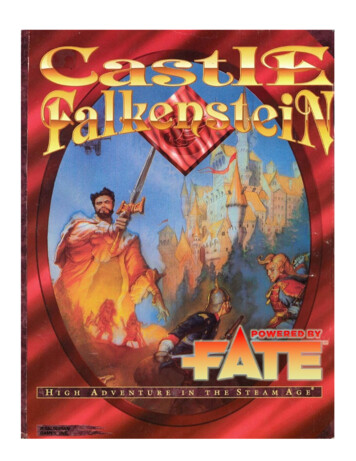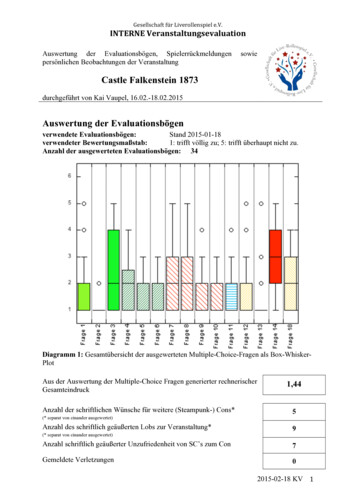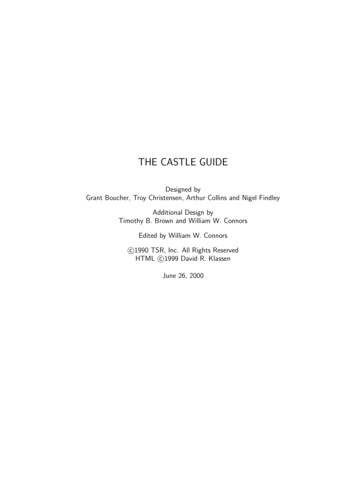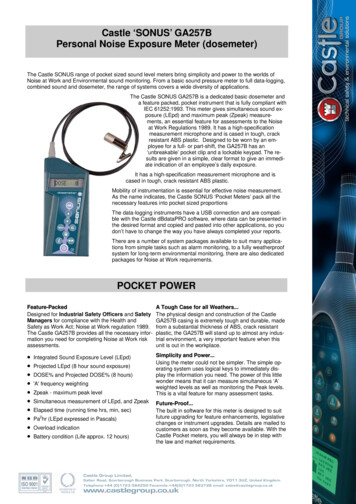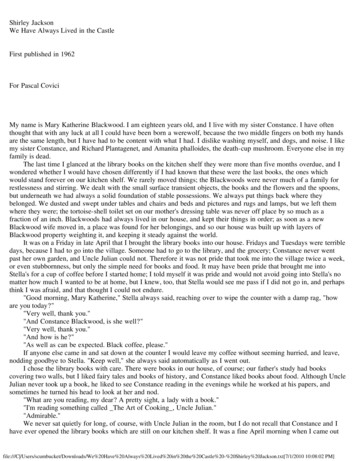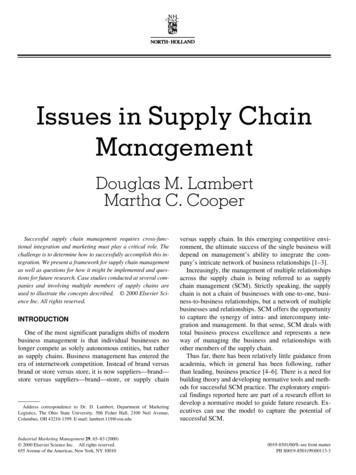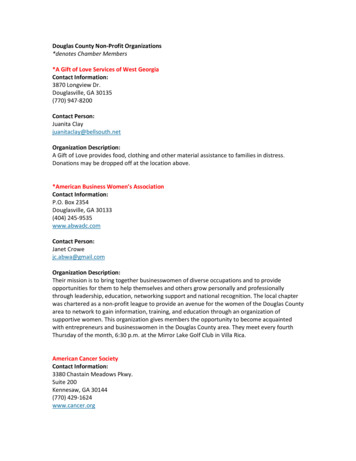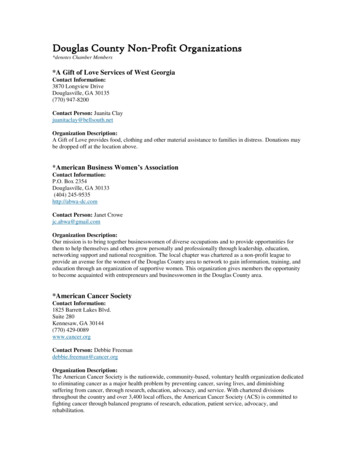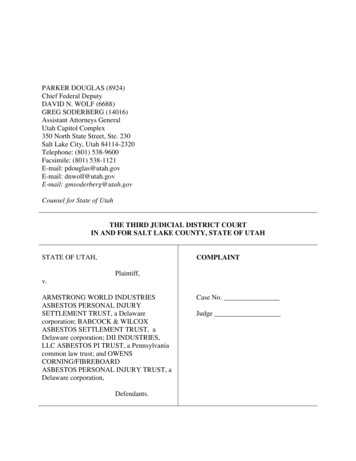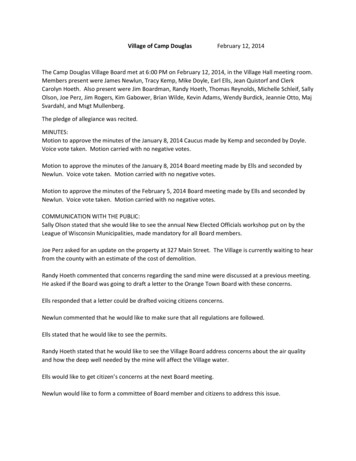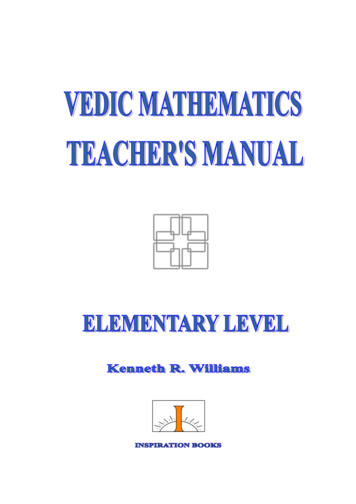
Transcription
Published by Inspiration Books, 2009,Kensglen, Nr Carsphairn, Castle Douglas, DG7 3TE, Scotland, U.K.ISBN 978-1-902517-16-2 K. R. Williams 2002First published in 2002 by Inspiration Books.Revised edition 2009.
PREFACEThis Manual is the first of three self-contained Manuals (Elementary,Intermediate and Advanced) which are designed for adults with a basicunderstanding of mathematics to learn or teach the Vedic system. So teacherscould use it to learn Vedic Mathematics, though it is not suitable as a text forchildren (for that the Cosmic Calculator Course is recommended). Or it could beused to teach a course on Vedic Mathematics. This Manual is suitable forteachers of children in grades 3 to 7.The sixteen lessons of this course are based on a series of one week summercourses given at Oxford University by the author to Swedish mathematicsteachers between 1990 and 1995. Those courses were quite intensive consistingof eighteen, one and a half hour, lessons.All techniques are fully explained and proofs are given where appropriate, therelevant Sutras are indicated throughout (these are listed at the end of theManual) and, for convenience, answers are given after each exercise. Crossreferences are given showing what alternative topics may be continued with atcertain points.It should also be noted that in the Vedic system a mental approach is preferredso we always encourage students to work mentally as long as it is comfortable.In the Cosmic Calculator Course pupils are given a short mental test at the startof most or all lessons, which makes a good start to the lesson, revises previouswork and introduces some of the ideas needed in the current lesson. In theCosmic Calculator course there are also many games that help to establish andpromote confidence in using the Vedic system.Some topics will be found to be missing in this text: for example, there is nosection on area, only a brief mention. This is because the actual methods are thesame as currently taught so that the only difference would be to give the relevantSutra(s).
CONTENTSPREFACELESSON 1 COMPLETING THEWHOLE1.11.21.31.41.51.6iii1INTRODUCTION1THE TEN POINT CIRCLE3MULTIPLES OF TEN4DEFICIENCY FROM TEN5DEFICIENCY AND COMPLETIONTOGETHER 5MENTAL ADDITION6COMPLETING THE WHOLE 7COLUMNS OF FIGURES 9BY ADDITION AND BYSUBTRACTION11SUBTRACTING NUMBERS NEAR ABASE 12LESSON 4 LEFT TO RIGHT404.1ADDITION: LEFT TO RIGHT404.2MULTIPLICATION: LEFT TO RIGHT 424.34.4DOUBLING AND HALVING43SUBTRACTION: LEFT TO RIGHT 444.5CHECKING SUBTRACTION SUMS454.6MORE SUBTRACTIONS46LESSON 55.15.25.3LESSON 2 DOUBLING ANDHALVING142.1142.22.32.42.5DOUBLINGMULTIPLYING BY 4, 8 16HALVINGSPLITTING NUMBERS 18DIVIDING BY 4, 8 18EXTENDING YOUR TABLESMULTIPLYING BY 5, 50, 25DIVIDING BY 5, 50, 25DIVIDING BY 5 21DIVIDING BY 50, 25 2217243.13.23.33.4242626293.53.63.73.8ADDING DIGITSTHE NINE POINT CIRCLECASTING OUT NINESDIGIT SUM PUZZLESMORE DIGIT SUM PUZZLES 30THE DIGIT SUM CHECKMULTIPLICATION CHECK 33THE VEDIC SQUAREPATTERNS FROM THE VEDICSQUARENUMBER LTIPLICATIONDIVISIONLESSON 7 BASEMULTIPLICATION7.17.27.3LESSON 3 DIGIT SUMSAPPLYING THE FORMULASUBTRACTIONADDING ZEROS 50ONE LESS 51ONE MORE 51ONE LESS AGAIN 52MONEYLESSON 6 NUMBER SPLITTING6.4192021ALL FROM 9 AND THELAST FROM 107.4TIMES TABLESNUMBERS JUST OVER TENMULTIPLICATION TABLEPATTERNSRECURRING DECIMALS 64NUMBERS CLOSE TO 100MENTALLY 67NUMBERS OVER 100 68MENTAL MATHS 695959616265RUSSIAN PEASANT MULTIPLICATION 69317.5347.636377.7LARGER NUMBERS70NUMBERS ABOVE THE BASE 71PROPORTIONATELY71ANOTHER APPLICATION OFPROPORTIONATELY 73MULTIPLYING NUMBERS NEARDIFFERENT BASES747.8SQUARING NUMBERS NEAR A BASE 757.9A SUMMARY77
CONTENTSLESSON 8 CHECKING ANDDIVISIBILITYLESSON 12 SQUARING788.1DIGIT SUM CHECK FOR DIVISION 788.2THE FIRST BY THE FIRST ANDTHE LAST BY THE LASTTHE FIRST BY THE FIRST 79THE LAST BY THE LAST 81DIVISIBILITY BY 4DIVISIBILITY BY 118.38.4798182REMAINDER AFTER DIVISION BY 11 83ANOTHER DIGIT SUM CHECK 84LESSON 9 BAR NUMBERS9.19.29.39.410.1 MULTIPLICATION BY 11CARRIES 94LONGER NUMBERS 9410.2 BY ONE MORE THAN THE ONEBEFORE10.3 MULTIPLICATION BY NINES10.4 THE FIRST BY THE FIRST ANDTHE LAST BY THE LAST10.5 USING THE AVERAGE10.6 SPECIAL NUMBERSREPEATING NUMBERS 101PROPORTIONATELY 102DISGUISES 102LESSON 11 GENERALMULTIPLICATION11.1 REVISION11.2 TWO-FIGURE NUMBERSCARRIES 10711.3 MOVING MULTIPLIER11.4 EXTENSION11.5 MULTIPLYING BINOMIALS11.6 MULTIPLYING 3-FIGURENUMBERS11.7 WRITTEN CALCULATIONS12.1 SQUARING NUMBERS THAT END IN511912.2 SQUARING NUMBERS NEAR 50 12012.3 GENERAL SQUARING121THE DUPLEX 12112.4 NUMBER SPLITTING12312.5 ALGEBRAIC SQUARING12412.6 DIGIT SUMS OF SQUARES12512.7 SQUARE ROOTS OF PERFECTSQUARES12612.8 3 AND 4 FIGURE NUMBERS12885REMOVING BAR NUMBERS85ALL FROM 9 AND THE LAST FROM10 87SUBTRACTION88CREATING BAR NUMBERS89USING BAR NUMBERS91LESSON 10 SPECIALMULTIPLICATION119929296979899101LESSON 13 EQUATIONS13013.1 ONE-STEP EQUATIONS13.2 TWO-STEP EQUATIONS13.3 THREE-STEP EQUATIONS130131132LESSON 14 FRACTIONS13414.1 VERTICALLY AND CROSSWISE14.2 A SIMPLIFICATION14.3 COMPARING FRACTIONS14.4 UNIFICATION OF OPERATIONS134136137138LESSON 15 SPECIAL DIVISION13915.1 DIVISION BY 9LONGER NUMBERS 141CARRIES 142A SHORT CUT 14215.2 DIVISION BY 8 ETC.15.3 DIVISION BY 99, 98 ETC.13915.4143145DIVISOR BELOW A BASE NUMBER 146TWO-FIGURE ANSWERS 14815.5105105106109111112114116DIVISOR ABOVE A BASE NUMBER 150LESSON 16 THE CROWNING GEM 15216.116.216.316.4SINGLE FIGURE ON THE FLAGSHORT DIVISION DIGRESSIONLONGER NUMBERSNEGATIVE FLAG DIGITS16.5DECIMALISING THE REMAINDER 159SUTRAS AND SUB-SUTRAS9-POINT CIRCLESREFERENCESINDEX OF THE VEDIC FORMULAEINDEX152153155157160162163164166
LESSON 1COMPLETING THE WHOLESUMMARY1.11.21.31.41.51.6Introduction - background information about Vedic Mathematics.The Ten Point Circle – representing numbers on a circle.Multiples of TenDeficiency from Ten – relating numbers to multiples of ten.Mental AdditionBy Addition and By Subtraction – of numbers near a multiple of ten.1.1 INTRODUCTIONVedic Mathematics is the ancient system of mathematics which was rediscovered early lastcentury by Sri Bharati Krsna Tirthaji (henceforth referred to as Bharati Krsna).The Sanskrit word “Veda” means “knowledge”. The Vedas are ancient writings whose date isdisputed but which date from at least several centuries BC. According to Indian tradition thecontent of the Vedas was known long before writing was invented and was freely available toeveryone. It was passed on by word of mouth. The writings called the Vedas consist of a hugenumber of documents (there are said to be millions of such documents in India, many ofwhich have not yet been translated) and these have recently been shown to be highlystructured, both within themselves and in relation to each other (see Reference 2). Subjectscovered in the Vedas include Grammar, Astronomy, Architecture, Psychology, Philosophy,Archery etc., etc.A hundred years ago Sanskrit scholars were translating the Vedic documents and weresurprised at the depth and breadth of knowledge contained in them. But some documentsheaded “Ganita Sutras”, which means mathematics, could not be interpreted by them in termsof mathematics. One verse, for example, said “in the reign of King Kamse famine, pestilenceand unsanitary conditions prevailed”. This is not mathematics they said, but nonsense.Bharati Krsna was born in 1884 and died in 1960. He was a brilliant student, obtaining thehighest honours in all the subjects he studied, including Sanskrit, Philosophy, English,Mathematics, History and Science. When he heard what the European scholars were sayingabout the parts of the Vedas which were supposed to contain mathematics he resolved tostudy the documents and find their meaning. Between 1911 and 1918 he was able toreconstruct the ancient system of mathematics which we now call Vedic Mathematics.
2VEDIC MATHEMATICS MANUAL 1He wrote sixteen books expounding this system, but unfortunately these have been lost andwhen the loss was confirmed in 1958 Bharati Krsna wrote a single introductory book entitled“Vedic Mathematics”. This is currently available and is a best-seller (see Reference 1).The present author came across the book “Vedic Mathematics” in 1971 and has beendeveloping the content of that book, and applying the system in other areas not covered byBharati Krsna, since then. Anything in this book which is not in “Vedic Mathematics” hasbeen developed independently by the author in this way.There are many special aspects and features of Vedic Mathematics which are better discussedas we go along rather than now because you will need to see the system in action to appreciateit fully. But the main points for now are:1) The system rediscovered by Bharati Krsna is based on sixteen formulae (or Sutras) andsome sub-formulae (sub-Sutras). These Sutras are given in word form: for example By OneMore than the One Before and Vertically and Crosswise. In this text they are indicated byitalics. The Sutras can be related to natural mental functions such as completing a whole,noticing analogies, generalisation and so on.2) Not only does the system give many striking general and special methods, previouslyunknown to modern mathematics, but it is far more coherent and integrated as a system.3) Vedic Mathematics is a system of mental mathematics (though it can also be writtendown).Many of the Vedic methods are new, simple and striking. They are also beautifullyinterrelated so that division, for example, can be seen as an easy reversal of the simplemultiplication method (similarly with squaring and square roots). This is in complete contrastto the modern system. Because the Vedic methods are so different to the conventionalmethods, and also to gain familiarity with the Vedic system, it is best to practice thetechniques as you go along.“The Sutras (aphorisms) apply to and cover each andevery part of each and every chapter of each and everybranch of mathematics (including arithmetic, algebra,geometry – plane and solid, trigonometry – plane andspherical, conics- geometrical and analytical,astronomy, calculus – differential and integral etc., etc.In fact, there is no part of mathematics, pure orapplied, which is beyond their jurisdiction”From “Vedic Mathematics”, Page xvi.
1: COMPLETING THE WHOLE31.2 THE TEN POINT CIRCLE12345678910. . .Numbers start with number one.Then comes number two, then three and so on.The Sutra By One More than the One Before describes the generation of numbers from unity.Arithmetic is the study of the behaviour of numbers and just as every person is different andspecial so it is with numbers.Every number is special and when we get to know numbers they are like friends.[Some discussion about numbers and where they appear could be introduced here.]1019Sometimes it is useful to have the first ten numbersaround a circle like this:8273465We use nine figures, and zero.For numbers beyond 9 we put two or moreof these together to make 10, 11, 12 and so on.199Continuing around the circle we can put 11where we have 1, but further out on the 1-branch.And number 12 goes next to 2 and so on.20102111118 82 1217 73 13616515414This circle can be used for adding on numbers, and for taking away, just as we use a numberline. Notice that the numbers on any branch all end with the same figure and that multiples often all appear on the top branch.
VEDIC MATHEMATICS MANUAL 141.3 MULTIPLES OF TENIt is important to know the five pairs of numbers that add up to 10:1 9 10,2 8 10,3 7 10,4 6 10,5 5 10.10198273465These pairs are shown on the 10-point circle above.The Sutra By the Completion or Non-Completion describes the ability we all have to see anduse wholeness.Practice AComplete the following additions:a 6 4b 4 16c 5 25d 13 7e 22 8f 38 2g 54 6h 47 3i 61 9j 85 5a 10f 40b 20g 60c 30h 50d 20i 70e 30j 90Completing tens can be done in another way.1For example, 24 26 is easy because the 4 and 6 make ten.So 24 26 50.“Little boys come dancing forward with joy and professorsask, ‘well, how can the answer be written down withoutany intermediate steps of working at all?’”.From “Vedic Metaphysics”, Page 168.
1: COMPLETING THE WHOLEPractice B5Add the following:a 37 23b 42 28c 54 16d 49 21e 45 35f 72 18g 38 22h 35 35a 60e 80b 70f 90c 70g 60d 70h 701.4 DEFICIENCY FROM TENThe Vedic Sutra By the Deficiency relates to the natural ability to see how much somethingdiffers from wholeness.2You can see that 39 is close to 40 and is 1 short of 40,and that 58 is close to 60 and is 2 short of 60.Practice CIn the following exercise fill in the missing numbers.a 37 is close toand isbelow.b 49 is close toand isbelow.a 40, 3b 50, 1c 68 is close toand isbelow.c 70, 2DEFICIENCY AND COMPLETION TOGETHERThis makes adding easier because we can complete a whole.338 5 ? You know that 38 is close to 40 and is 2 below it.So take 2 of the 5 to make up to 40 and you have 3 more to add on,which gives 43.38 40 43
VEDIC MATHEMATICS MANUAL 16We can imagine a number line, or draw one out or use the 10-point circle to add numbers likethis.Practice Da 49 5b 58 3c 37 6d 28 6e 79 6f 38 7g 57 7h 69 4a 54e 85b 61f 45c 43g 64d 34h 731.5 MENTAL ADDITION4When an addition sum has a carry, like 56 26 you can add them in your head, likethis:In 56 26 you get 7 tens or 70.5 6Then in the units you have 6 6 12. And 70 12 82. 2 6So 56 26 82.8 21You could also write this as 56 26 712 82, writing the 12 as 12 to show that the1 in the 12 has to be carried to the left.5Similarly, 48 45 813 93.You can write the extra step if you like but try to do the whole thing in your head if possible.Practice ETry these:a 37 47b 55 28c 47 25d 29 36e 56 25f 38 26g 29 44h 35 49a 84e 81b 83f 64c 72g 73d 65h 84“The Sutras are easy to understand, easy to applyand easy to remember; and the whole work can betruthfully summarised in one word “mental”.From “V
mental maths 69 russian peasant multiplication 69 7.5 larger numbers 70 numbers above the base 71 7.6 proportionately 71 another application of proportionately 73 7.7 multiplying numbers near different bases 74 7.8 squaring numbers near a base 75 7.9 a summary 77. lesson 8 checking and divisibility 78 8.1 digit sum check for division 78 8.2 the first by the first and the last by the last 79 .
